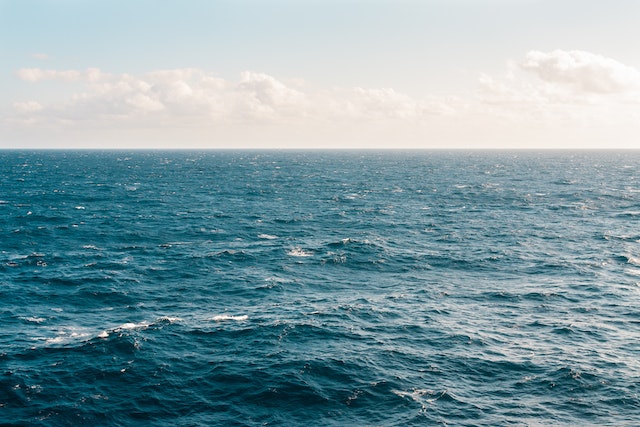
How have sea levels changed over time? Over the last 542 million years they have varied from 130 m lower than their level today to a theoretical 300 m higher than they are today. It is theoretical because the continents move around a lot, and it is difficult to find evidence for where the seas were.
The oceans materialized about 3.8 billion years ago. When Earth was formed, 4.5 billion years ago, it was a ball of molten rock and metal. The metals were more dense than the rock and they slowly sank to the middle of the planet, giving us the iron core we have at the moment. The outer mantle slowly cooled until it became solid rock. This took about 10 million years after the formation of Earth. By 4.1 billion years ago, the outer mantle was pretty solid, and the oceans might have formed then, but we were probably hit by another planet. That liquified the mantle again and formed the moon. It took until about 3.8 billion years ago for the temperature of the Earth’s surface to cool below the boiling point of water and water that had been in the atmosphere began to condense and fall to Earth. This became the oceans. Nobody knows how the water came to be on Earth. It could have been inside the planet and volcanoes threw it into the atmosphere. It could have arrived on meteors and comets. It could have arrived on the planet that hit us and became the moon. Nobody knows. However, approximately 700 million years after the Earth formed, we had oceans.
So, how high was the sea level when the oceans formed? Well, after the oceans formed, there wasn’t much, if any, land sticking out of the oceans, so it is impossible to measure their height. For land to rise out of the oceans, the mantle has to be very thick, thicker than the ocean is deep. Even though the Earth had cooled enough to allow the oceans to form 3.8 billion years ago, it was still very hot, and the mantle was quite soft. A soft mantle cannot be thick in some places and thin in others because it wants to be level, like a liquid. It certainly can’t support mountain ranges. It took another 1.4 billion years after the oceans formed for the mantle to cool enough to let it become thicker in some places and to support mountains. About 2.4 billion years ago, land suddenly emerged out of the oceans and there were huge changes on our planet. This also coincides with the Great Oxidation Event, which was the first mass extinction event on our planet, but ultimately made it possible for us to be here.
The Great Oxidation Event was caused by the bacteria that lived in the oceans using carbon dioxide and sunlight to photosynthesize. Oxygen is a byproduct of this, but there were no organisms on Earth to use the oxygen, so it slowly built up in the atmosphere. This caused a reverse greenhouse effect and Earth cooled down. There was a drop in volcanic activity and rising levels of land also affected the climate because land reflects more sunlight back than sea does. Earth froze over. Sea levels dropped to their lowest levels, 130 m lower than today, because most of the water was frozen.
Over the next 1.5 billion years, the atmosphere balanced itself out, most of the ice melted and the seas went down again. The warming was probably partly caused by the creation of tectonic plates, which increased the amount of volcanic activity, warming the atmosphere. Moving plates also pushed some pieces of land higher and pushed some parts of the ocean lower, altering the heights of the oceans. Earth goes through ice ages every now and again, but the position of the continents makes a large difference in the heights of the oceans. If there is a lot of land mass at the poles, the ice freezes on land and sea levels are very low because it is kept out of the water. If most of the land masses are near the equator, then sea levels are high because the water freezes in the sea.
About 800 million years ago, the planet froze again. This is a period called Snowball Earth and it probably happened because the supercontinent called Rodina broke up. When Rodina broke up, the crumbling and weathering rocks absorbed carbon dioxide, removing it from the atmosphere. At the same time, there were several super volcanoes that erupted, putting sulfur and ash into the atmosphere, blocking out the sun. The planet froze and sea levels plummeted.
During snowball Earth, the tectonic plates kept moving and undersea volcanoes slowly increased the amount of CO2 in the atmosphere. The masses of ice melted into the oceans and sea levels rose to close to their maximum, which was about 300 m higher than they are today. The amount of CO2 levelled off and the seas shrank down to about 250 m higher than today, and they stayed that way until about 350 million years ago. Large ice sheets formed at the south pole and several continents were raised out of the sea at the same time. These combined factors caused sea levels to drop drastically. This increased the amount of land available and land fauna and flora flourished.
Earth gradually warmed up through the time of the dinosaurs and the sea levels slowly rose. The ice sheets disappeared, and the sea levels reached a height 250 m higher than they are today. From 100 million years ago, the temperature began to shift the other way and the ice sheets reformed. The sea levels dropped, peaking at their lowest during the last ice age, before reaching the height they are today. And that is what I learned today.
Photo by Kellie Churchman: https://www.pexels.com/photo/landscape-photograph-of-body-of-water-1001682/
Sources
https://en.wikipedia.org/wiki/Past_sea_level
https://ocean.si.edu/through-time/ancient-seas/sea-level-rise
https://en.wikipedia.org/wiki/History_of_Earth
https://phys.org/news/2018-05-sea-billion-years-planet-earth.html
https://www.newscientist.com/article/dn18949-the-history-of-ice-on-earth/
https://asm.org/Articles/2022/February/The-Great-Oxidation-Event-How-Cyanobacteria-Change
https://www.science.org/doi/10.1126/science.aap8612
https://www.earthmagazine.org/article/when-and-how-did-plate-tectonics-begin-earth
https://www.climate.gov/news-features/climate-qa/whats-hottest-earths-ever-been
https://www.science.org/content/article/ancient-snowball-earth-thawed-out-flash
